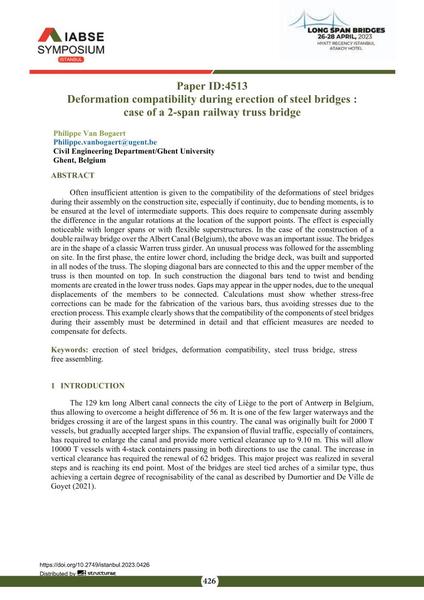Deformation compatibility during erection of steel bridges: case of a 2-span railway truss bridge

|
|
|||||||||||
Détails bibliographiques
| Auteur(s): |
Philippe Van Bogaert
(Civil Engineering Department/Ghent University Ghent, Belgium)
|
||||
|---|---|---|---|---|---|
| Médium: | papier de conférence | ||||
| Langue(s): | anglais | ||||
| Conférence: | IABSE Symposium: Long Span Bridges, Istanbul, Turkey, 26-28 April 2023 | ||||
| Publié dans: | IABSE Symposium Istanbul 2023 | ||||
|
|||||
| Page(s): | 426-433 | ||||
| Nombre total de pages (du PDF): | 8 | ||||
| Année: | 2023 | ||||
| DOI: | 10.2749/istanbul.2023.0426 | ||||
| Abstrait: |
Often insufficient attention is given to the compatibility of the deformations of steel bridges during their assembly on the construction site, especially if continuity, due to bending moments, is to be ensured at the level of intermediate supports. This does require to compensate during assembly the difference in the angular rotations at the location of the support points. The effect is especially noticeable with longer spans or with flexible superstructures. In the case of the construction of a double railway bridge over the Albert Canal (Belgium), the above was an important issue. The bridges are in the shape of a classic Warren truss girder. An unusual process was followed for the assembling on site. In the first phase, the entire lower chord, including the bridge deck, was built and supported in all nodes of the truss. The sloping diagonal bars are connected to this and the upper member of the truss is then mounted on top. In such construction the diagonal bars tend to twist and bending moments are created in the lower truss nodes. Gaps may appear in the upper nodes, due to the unequal displacements of the members to be connected. Calculations must show whether stress-free corrections can be made for the fabrication of the various bars, thus avoiding stresses due to the erection process. This example clearly shows that the compatibility of the components of steel bridges during their assembly must be determined in detail and that efficient measures are needed to compensate for defects. |
||||
